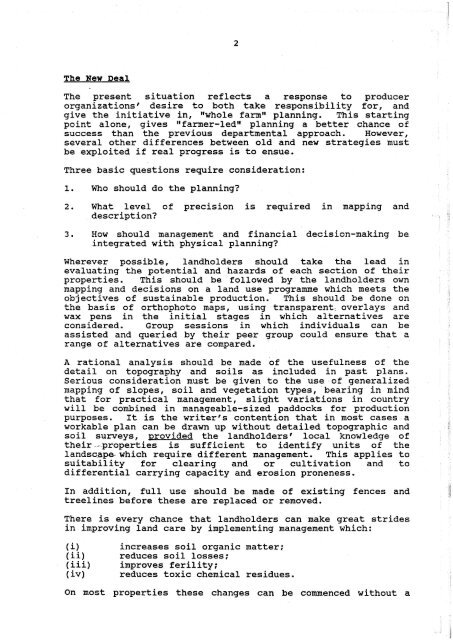soil-conservation-people-religion-and-land.pdf - South West NRM
soil-conservation-people-religion-and-land.pdf - South West NRM
soil-conservation-people-religion-and-land.pdf - South West NRM
Create successful ePaper yourself
Turn your PDF publications into a flip-book with our unique Google optimized e-Paper software.
The New Deal<br />
The present situation reflects a response to producer<br />
organizationsf desire to both take responsibility for, <strong>and</strong><br />
give the initiative in, "whole farma1 planning. This starting<br />
point alone, gives "farmer-ledln planning a better chance of<br />
success than the previous departmental approach. However,<br />
several other differences between old <strong>and</strong> new strategies must<br />
be exploited if real progress is to ensue.<br />
Three basic questions require consideration:<br />
1. Who should do the planning?<br />
2. What level of precision is required in mapping <strong>and</strong><br />
description? 3<br />
3. How should management <strong>and</strong> financial decision-making be<br />
integrated with physical planning?<br />
Wherever possible, l<strong>and</strong>holders should take the lead in<br />
evaluating the potential <strong>and</strong> hazards of each section of their<br />
properties. This should be followed by the l<strong>and</strong>holders own<br />
mapping <strong>and</strong> decisions on a l<strong>and</strong> use programme which meets the<br />
objectives of sustainable production. This should be done on<br />
the basis of orthophoto maps, using transparent, overlays <strong>and</strong><br />
wax pens in the initial stages in which alternatives are<br />
considered. Group sessions in which individuals can be<br />
assisted <strong>and</strong> queried by their peer group could ensure that a<br />
range of alternatives are compared.<br />
A rational analysis should be made of the usefulness of the<br />
detail on topography <strong>and</strong> <strong>soil</strong>s as included in past plans.<br />
Serious consideration must be given to the use of generalized<br />
mapping of slopes, <strong>soil</strong> <strong>and</strong> vegetation types, bearing in mind<br />
that for practical management, slight variations in country<br />
will be combined in manageable-sized paddocks for production<br />
purposes. It is the writer's contention that in most cases a<br />
workable plan can be drawn up without detailed topographic <strong>and</strong><br />
<strong>soil</strong> surveys, provided the l<strong>and</strong>holdersf local knowledge of<br />
their-=-properties is sufficient to identify units of the<br />
l<strong>and</strong>scape which require different management. This applies to<br />
suitability for clearing <strong>and</strong> or cultivation <strong>and</strong> to<br />
differential carrying capacity <strong>and</strong> erosion proneness.<br />
In addition, full use should be made of existing fences <strong>and</strong> 1<br />
treelines before these are replaced or removed.<br />
There is every chance that l<strong>and</strong>holders can make great strides<br />
in improving l<strong>and</strong> care by implementing management which:<br />
(i) increases <strong>soil</strong> organic matter;<br />
(ii) reduces <strong>soil</strong> losses;<br />
(iii) improves f erility ;<br />
(iv) reduces toxic chemical residues.<br />
On most properties these changes can be commenced without a<br />
I
















